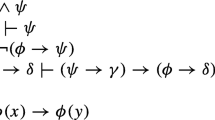Abstract
We study how a logic C+J conbining classical logic C and intuitionistic logic J can be defined. We show that its Hilbert axiomatization cannot be attained by simply extending the union of the axiomatizations of C and J by so called interaction axioms. Such a logic would collapse into classical logic.
Access this chapter
Tax calculation will be finalised at checkout
Purchases are for personal use only
Preview
Unable to display preview. Download preview PDF.
Similar content being viewed by others
References
L. Catach (1988), Normal multimodal logics. Proc. Nat. Conf. on AI (AAAI-88), pp 491–495.
B. Chellas (1975), Basic conditional logics. Journal of Philosophical Logic 4, pp 133–153.
M. Fitting (1983), Proof methods for modal and intuitionistic logics. Synthese Library, Vol. 169, D. Reidel Publishing Company, Dordrecht.
D. Gabbay (1996), Labelled Deductive Systems. Oxford University Press, to appear.
L. Humberstone (1979), Interval semantics for tense logic: some remarks. Journal of Philosophical Logic 8, pp 171–196.
M. Kracht (1993), How completeness and correspondence theory got married. In: M. de Rijke (ed.), Diamonds and Defaults. Synthese, Kluwer.
S. Kripke (1965), Semantical analysis of intuitionistic logic, I. In: J. N. Crossley, M. A. E. Dummet (eds.), Formal systems and recursive functions. Amsterdam, North Holland Publishing Co., pp 92–129.
D. Ladner (1977), The computational complexity of provability in systems of modal propositional logic. SIAM J. Computing 3, pp. 467–480.
D. Nute (1980), Topics in conditional logic. Philosophical Studies Series, D. Reidel, Dordrecht.
D. Nute (1984), Conditional logic. In Dov M. Gabbay and Franz Guenthner (eds.), Handbook of Philosophical Logic. D. Reidel, Dordrecht.
R. Statman (1979), Intuitionistic propositional logic is polynomial-space complete. Theoretical Computer Science 9, pp 67–72.
Author information
Authors and Affiliations
Editor information
Editors and Affiliations
Rights and permissions
Copyright information
© 1996 Springer Science+Business Media New York
About this chapter
Cite this chapter
del Cerro, L.F., Herzig, A. (1996). Combining Classical and Intuitionistic Logic. In: Baader, F., Schulz, K.U. (eds) Frontiers of Combining Systems. Applied Logic Series, vol 3. Springer, Dordrecht. https://doi.org/10.1007/978-94-009-0349-4_4
Download citation
DOI: https://doi.org/10.1007/978-94-009-0349-4_4
Publisher Name: Springer, Dordrecht
Print ISBN: 978-94-010-6643-3
Online ISBN: 978-94-009-0349-4
eBook Packages: Springer Book Archive




